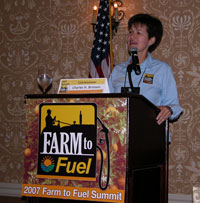 Despite a very limited availability in the Sunshine State, Florida consumers appear receptive to purchasing ethanol-enriched fuel at the pumps.
Despite a very limited availability in the Sunshine State, Florida consumers appear receptive to purchasing ethanol-enriched fuel at the pumps.
A national survey released by the Ethanol Promotion and Information Council (EPIC) found that while Florida has a slightly lower familiarity with ethanol than the national average, more than 70 percent of respondents in the state said they were likely to purchase the renewable fuel after being provided with relevant information on the topic.
“Our research is proof that Floridians are open to ethanol and there is a consensus among several state leaders that the production and use of ethanol in Florida will be a major benefit to its citizens. We look forward to a resolution on any remaining regulatory hurdles,” said Tom Slunecka, executive director for the Ethanol Promotion and Information Council (EPIC). “More than half the states in America, including California, have recognized the benefits of ethanol and we’re confident that Florida will join the movement yet this year.”
With one of the nation’s fastest growing populations, Florida depends almost exclusively on other states and nations for supplies of oil and gasoline.


 Presentations from the 2007 Farm to Fuel Summit in Florida are now available on-line at
Presentations from the 2007 Farm to Fuel Summit in Florida are now available on-line at  No, it’s not cheap biodiesel… although it certainly could end up being biodiesel for just peanuts. What I’m talking about is scientists at the USDA’s Agricultural Research Service looking at using peanuts as the feedstock for biodiesel… maybe even cheaper than soybeans.
No, it’s not cheap biodiesel… although it certainly could end up being biodiesel for just peanuts. What I’m talking about is scientists at the USDA’s Agricultural Research Service looking at using peanuts as the feedstock for biodiesel… maybe even cheaper than soybeans.
 Florida stands ready to fill up and feel good as it endeavors to become a leader in both the production and consumption of biofuels, including ethanol.
Florida stands ready to fill up and feel good as it endeavors to become a leader in both the production and consumption of biofuels, including ethanol.  According to the
According to the  Recent rain in the Midwest has helped the corn crop rebound and led to lower corn prices, according to a
Recent rain in the Midwest has helped the corn crop rebound and led to lower corn prices, according to a  The American Wind Energy Association is calling on Congress to enact a Renewable Electricity Standard (RES). Leaders from the AWEA will join with Congressmen Tom Udall (D-NM) and Mark Udall (D-CO) on Tuesday, July 31st at 10 a.m. at the U.S. Capitol to call for wider support of the amendment that would require power companies to use 20 percent renewable sources to produce energy by the year 2020. Pennsylvania Congressman Todd Platts (R. PA) is also a co-sponsor of the measure.
The American Wind Energy Association is calling on Congress to enact a Renewable Electricity Standard (RES). Leaders from the AWEA will join with Congressmen Tom Udall (D-NM) and Mark Udall (D-CO) on Tuesday, July 31st at 10 a.m. at the U.S. Capitol to call for wider support of the amendment that would require power companies to use 20 percent renewable sources to produce energy by the year 2020. Pennsylvania Congressman Todd Platts (R. PA) is also a co-sponsor of the measure. At the recent Farm to Fuel Summit in Florida, the state’s chief financial officer told the crowd that biofuels have made it into the mainstream.
At the recent Farm to Fuel Summit in Florida, the state’s chief financial officer told the crowd that biofuels have made it into the mainstream.  CFO Alex Sink related a story of how she had gone into her local Circle K convenience store that morning for coffee and newspapers on the way to the conference and the clerk at the counter noticed her “Farm to Fuel” shirt and asked her what she did. “I said I’m getting ready to go to a conference to talk about ways to grow crops to turn into fuel,” Sink said. “And she said, ‘You mean like ethanol?’ and I said ‘yeah’ and she said ‘that’s good, that’s very good, we need to protect our ozone layer.'”
CFO Alex Sink related a story of how she had gone into her local Circle K convenience store that morning for coffee and newspapers on the way to the conference and the clerk at the counter noticed her “Farm to Fuel” shirt and asked her what she did. “I said I’m getting ready to go to a conference to talk about ways to grow crops to turn into fuel,” Sink said. “And she said, ‘You mean like ethanol?’ and I said ‘yeah’ and she said ‘that’s good, that’s very good, we need to protect our ozone layer.'”